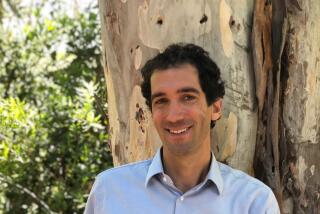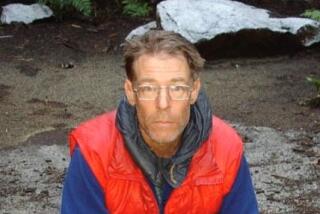LIVING AT THE END OF TIME by John Hanson Mitchell <i> (Houghton Mifflin: $18.95; 223 pp.) </i>
- Share via
Henry Thoreau, mystic, surveyor, naturalist and inventor of machines for his father’s pencil factory, was wary of technology but not afraid of it.
Things have changed by the 1980s, when John Hanson Mitchell, newly separated from his wife, builds a cabin on a forested ridge near Concord, Mass., and hunkers down to mark the passing seasons, much as Thoreau did at Walden Pond in 1845. The Bomb exists. Traffic roars by on the “high-tech highways” west of Boston. A huge Digital Equipment computer complex is rising across the valley on what used to be an orchard.
On his doomed scrap of wilderness, Mitchell tries to fine-tune his sensibility to receive the same messages from the Earth that Thoreau heard. Like a short-wave operator, he picks up an eclectic mix. He sees bear droppings in a place where the last bear was killed in 1811; he thinks he sees the ghost of an Indian where Indians vanished even earlier. Unable to wish the Digital plant away, he tours it and finds a conference room named after Thoreau.
Mitchell makes such an effort to focus on nature that all else is blurred. He can name every bird and wildflower in the woods, but, the reader wonders, how does he make money? Why did his marriage break up? What about his children who drift in and out of this learned and charming memoir less keenly observed than bullfrogs or snow?
After a year in the cabin, without electricity or running water, Mitchell concludes that he is less of a purist than Thoreau. He cuts his grass with a scythe instead of a power mower, but he cuts it nevertheless. He plants flowers. He reads Thoreau’s journals, then those of his grandfather, his father and a naturalist cousin in Maryland, finding links and correspondences everywhere. Finally, he decides to build a real house on the ridge, a house of 19th-Century design--”to beat (the developers) at their own game,” since they can’t be stopped.
In Thoreau’s writings there is a bracing self-assurance, as if he could pit his vision against the modern world on equal terms. Mitchell, on the other hand, gropes for an accommodation. He is not alone. The best parts of “Living at the End of Time” are portraits of the people he meets on the ridge. A widow who dresses as if for church to tend her garden, an Eastern European couple who fled the Nazis and farm self-sufficiently to “live without the state,” a hermit who wears skins and eats wild herbs, a drunk who camps in a freeway cloverleaf, a woman who weaves Indian baskets, a 95-year-old man who never left Concord and feels that he has missed nothing. All these characters evoke, for Mitchell, the myth of the “Green Man,” living on the fertile margin between the civilized and the wild.
More to Read
Sign up for our Book Club newsletter
Get the latest news, events and more from the Los Angeles Times Book Club, and help us get L.A. reading and talking.
You may occasionally receive promotional content from the Los Angeles Times.










